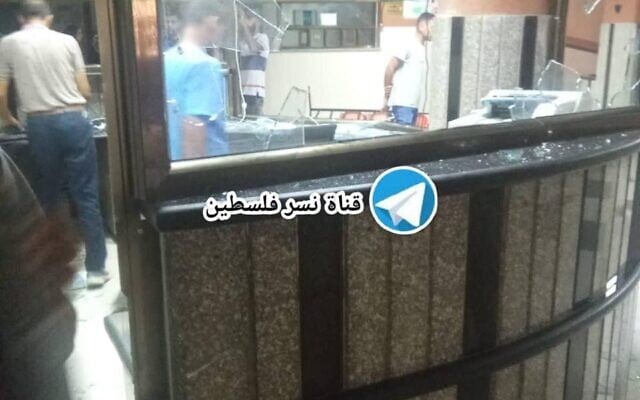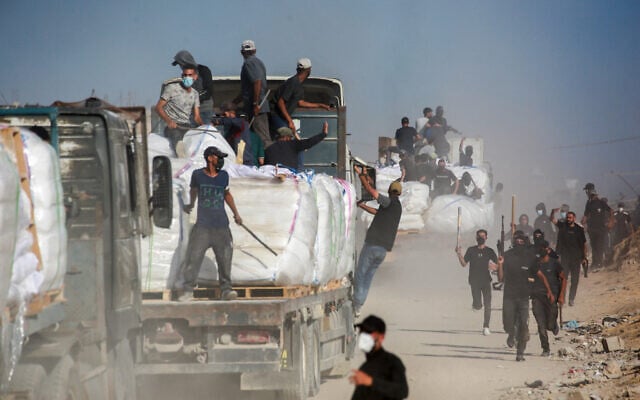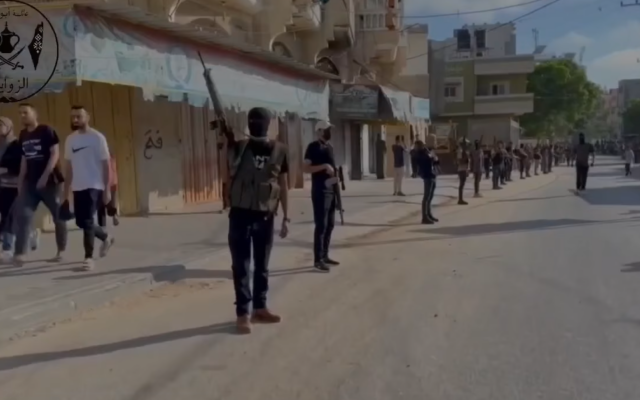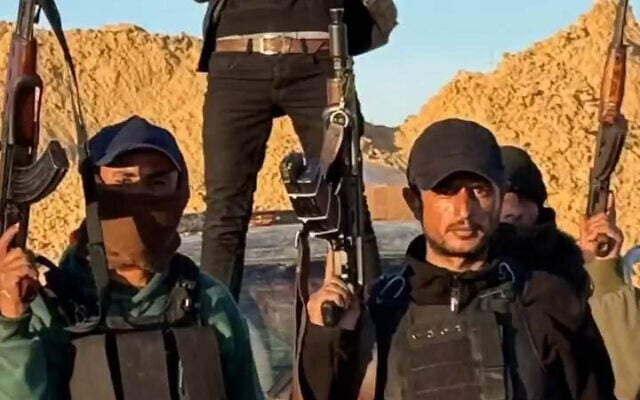


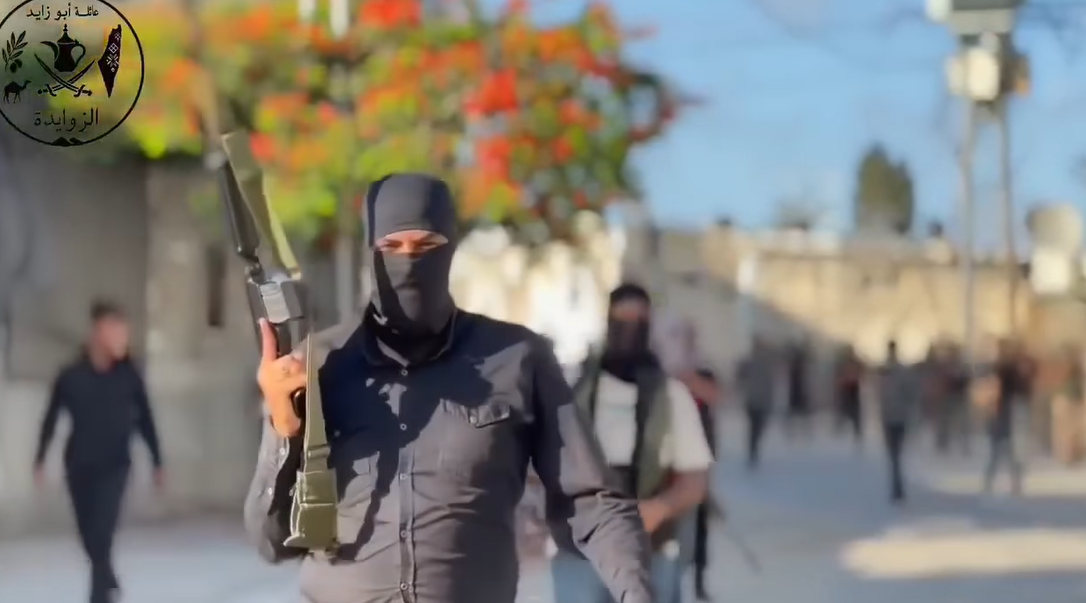
A powerful Gaza family exchanged fire with Hamas last week at a major hospital in Khan Younis, in a conflict that ended with burned vehicles and destroyed equipment.
Hamas and the Barbakh clan blamed each other for the fight at Nasser Hospital: While Hamas claims it acted against a Barbakh relative who had stolen aid — and blamed the clan for damaging the hospital — anti-Hamas media outlets allege that Hamas operatives took refuge inside Nasser after murdering a clan member.
The clash then morphed into a war of words. The Barbakh family lashed out against the terror group in a post on a popular anti-Hamas Telegram channel, alleging that since Hamas’s 2007 takeover of the territory, “the Barbakh family has paid the price for its positions and has been subjected to Hamas repression. The time for a response has come.”
The family is not alone: For the first time in nearly two decades of Hamas rule in Gaza, large, heavily armed clans are openly defying the terror group, through both public statements and armed confrontations. The opposition marks a serious challenge to Hamas’s ability to maintain local control, and comes amid the group’s declining military strength and waning popularity among Gazans as the nearly 21-month-old war with Israel drags on.
Israel has suggested that the clans could supplant Hamas rule in Gaza, but this is not necessarily a positive prospect: Even as they’ve begun to publicly counter Hamas, the families have continued to harshly criticize Israel and distance themselves from it.
Despite growing perceptions of armed clans gaining influence in parts of Gaza, Michael Milshtein, head of the Palestinian Studies Forum at Tel Aviv University, told The Times of Israel that the phenomenon remains geographically limited to the southern Gaza Strip and does not yet pose a serious threat to Hamas.
“At this stage, I see the clans as a nuisance and a challenge to Hamas — but not a real threat to its rule, and certainly not a coherent or viable partner for Israel for the day after,” he said.
“I still see Hamas as the dominant force in Gaza, particularly through its special unit ‘Saham,’ which is responsible for maintaining public order, especially in the northern Strip,” he said. “In the south, where the IDF has more control, we’re seeing more of these clan-related phenomena.”
The Gaza clans consist of dozens of extended families whose total populations range from hundreds to thousands of members, though exact numbers are hard to come by. The clans, which are typically linked by distant kinship and shared patriarchal lineage, serve as crucial sources of economic and social support. For many, clan identity surpasses the national Palestinian cause.
The families are often concentrated in particular areas of the Strip. The Barbakh clan, according to videos it has circulated, operates in southern Gaza around the cities of Rafah and Khan Younis, while the Abu Ziyad family is based in the village of Zawaida, near Deir al-Balah in the center of the territory.
Prior to the Hamas-led attack on October 7, 2023, the families organized under an umbrella group called the “Clans Committee,” originally founded in 2012 by West Bank-based Palestinian Authority President Mahmoud Abbas. The committee provided an avenue for the clans to maintain tribal courts to resolve disputes and violent incidents through customary mechanisms like financial settlements.
The committee continued operating under Hamas control after Abbas called for its dissolution in 2019. Clan leaders regularly held public visits with Gaza officials under the committee’s auspices. In July 2023, representatives of the committee even traveled to Cairo to meet with then-Hamas leader Ismail Haniyeh.
For the nearly 20 years it has controlled Gaza, Hamas was able to coexist with the clans. Violent clashes were rare, occurring only when Hamas saw the families as a threat to its authority. More often, it co-opted their influence to pursue its own goals, while in other instances, it ensured that they remained focused on internal matters without challenging its authority.
But that informal pact now appears to be fraying.
Much of the recent friction revolves around aid distribution — a fraught issue across the Strip.
As Hamas, Israel and other parties have competed over control of a limited supply of humanitarian assistance, footage and eyewitnesses from Gaza suggest that armed clans are becoming more involved in securing the aid — and, perhaps, stealing it. Whom they are working for, and the payment they have received, remains unclear.
“Some of the aid coming in today is being secured by large families,” said a resident of northern Gaza who spoke to The Times of Israel and asked to remain anonymous.
He described the clans as a “reliable force,” adding, “They protected aid and prevented looting of the humanitarian shipments coming into Gaza.”
But the clans’ involvement in aid distribution has also brought bloodshed. A recent video posted from Gaza shows the Abu Ziyad clan accusing Hamas of killing a relative who tried to stop the terror group from stealing humanitarian aid.
The family demanded that Hamas hand over the operatives responsible for the killing. Otherwise, the clan said, it would “go to war against Hamas.”
The families are able to both secure aid and fight Hamas because, footage indicates, their members increasingly carry light firearms.
Where these guns came from is unclear. It’s possible that some have trickled down — intentionally or not — from Hamas, which has spent the better part of two decades amassing significant weapon stockpiles through purchases, smuggling, and local manufacturing.
Some reports indicate that clans have used their position to steal aid meant for UN-affiliated humanitarian organizations operating in Gaza. A confidential UN memo obtained by The Washington Post in November 2024 identified Yasser Abu Shabab, a clan leader who has since cooperated with Israel, as “the principal and most influential figure behind the systematic and large-scale looting of aid convoys.”
On June 1, a Telegram channel affiliated with Hamas reported that an “armed family” had stolen humanitarian aid near Khan Younis that was intended for distribution in northern Gaza.
And on June 17, a video circulated from the Barbakh family that appeared to show their members escorting Gazans walking from Rafah northward toward Khan Younis, carrying food packages bearing the logo of the US- and Israeli-backed Gaza Humanitarian Foundation. In the footage, Gazans are seen thanking the family as armed men stand alongside them.
Hamas is still managing to cooperate with some clans. In recent weeks, Hamas-affiliated media published footage of humanitarian aid being distributed in Gaza City under clan protection. Armed men could be seen securing the aid trucks — an unusual show by Hamas, which rarely publicizes such aid distributions.
But in response, the Clans Committee issued statements denying any connection between Hamas or other factions and the delivery of humanitarian assistance.
The clans’ recent opposition to Hamas marks a departure from their stance throughout most of the war, when they largely directed their criticism at Israel. While Israel has conveyed that it hopes to see the clans take power in Gaza following the war, the families have publicly chafed at those plans.
In March 2024, for example, Aqef al-Masri, presented in Gazan media as a coordinator of the clan leadership committee, told Yemeni media that “Israel is a criminal state using illegal weapons to destroy the Palestinian people.”
That same month, the Clans Committee issued a statement declaring that the families “refuse to cooperate with Israel in the distribution of humanitarian aid.”
On May 11 this year, a demonstration was held in Gaza by clan leaders opposing the use of their families to distribute humanitarian aid under Israel’s control. During the rally, one clan leader declared, “Gaza will die but not surrender. Gaza will die but will not become a stick in the hand of the occupier under the pretext of humanitarian aid distribution.”
Israel had attempted to promote clan-led governance in Gaza as an alternative to Hamas at the beginning of the war. In January 2024, the IDF presented a plan to the security cabinet proposing that clans control specific areas of the Strip, where they would manage humanitarian aid distribution.
But by March 2024, the Saudi newspaper Asharq Al-Awsat reported that most talks between Israel and Gaza clans to form an alternative authority had failed. Many clans refused Israel’s proposal that they secure specific areas, fearing retaliation from Hamas operatives still active in Gaza.
That June, Prime Minister Benjamin Netanyahu confirmed in an interview with Channel 14 that Hamas had assassinated clan leaders whom Israel had tried to recruit. It was one of the main reasons, he said, that the plan failed.
By June 2025, however, Netanyahu confirmed that his government was still arming clans in Gaza to oppose Hamas, saying that “in consultation with security officials, we made use of clans in Gaza that are opposed to Hamas.”
“What’s wrong with that?” he said in a video posted by the Prime Minister’s Office. “It’s only good. It saves the lives of IDF soldiers.”
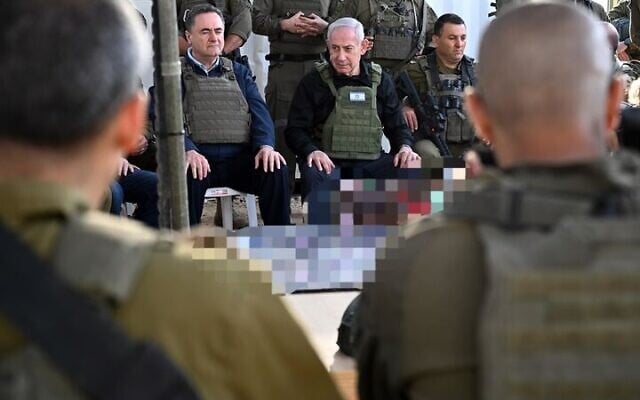
Yasser Abu Shabab denied Israeli support in an interview last month with an Israeli journalist from Army Radio, repudiating the prime minister’s claim that he collaborates with Israel or receives weapons from it.
“We do not work with Israel,” he said. “Our goal is to protect Palestinians from Hamas’s terror. Our weapons are not from Israel — they are simple arms we collected from the local population.”
Even if some families gradually do consolidate power in certain parts of Gaza as Hamas’s control falters, it remains unclear how they would treat Israel — or whether they might eventually direct their weapons against the IDF.
A statement released by the Barbakh family following the firefight at Nasser Hospital referred to Hamas as “agents of the occupation.” The message went on to warn against internecine war in Gaza, claiming, “This is exactly what the Zionist occupation wants.”
Hamas has also continued to wage a media campaign against dissenting clans — and claims that it retains the families’ support. After the same armed confrontation with the Barbakh family at Nasser Hospital in which the family condemned Hamas, the terror group released a statement through its affiliated media that, it claimed, was made on behalf of the Barbakh clan whose members had just shot at its operatives.
“We, the Barbakh family, do not accept such individual actions,” the falsified statement said. It went on to demand punishment for the offenders, and to “call on the relevant authorities to act firmly and legally.”
For Milshtein’s part, the old adage “The enemy of my enemy is my friend” does not stand when it comes to replacing Hamas rule with clan leadership.
“I try to apply common sense and ask myself: How can anyone support criminal, unhinged actors like the Abu Shabab clan and others — some of whom were previously involved in attacks against Israel — and others who are reviled in Palestinian society? How can anything good come out of that?” he asked.
“Based on my historical perspective, looking at past cases like the South Lebanon Army established by Israel [during the seventies], this kind of thing can go from being detrimental to an outright failure. I think there is a mix-up between heartfelt desires and clear-eyed, realistic assessments of the situation,” said Milshtein.

